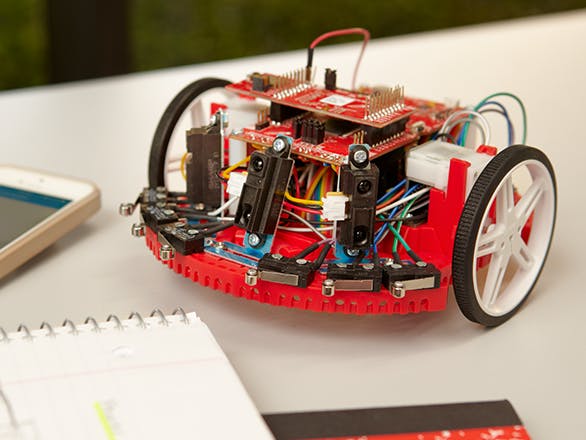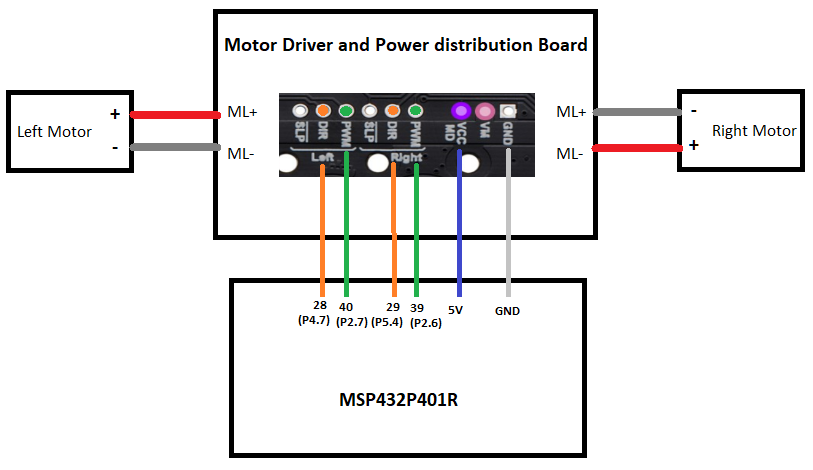Hardware components | ||||||
 |
| × | 1 | |||
Software apps and online services | ||||||
 |
| |||||
Hand tools and fabrication machines | ||||||
 |
| |||||
We will be making a robot that will accept user command and follow it accordingly.It is programmed in such a way that it will take certain commands like: START, STOP, LEFT, RIGHT, BACKWARD and FORWARD. For this we will be needing TI-RSLK. It contains MSP432 microcontroller, Pololu board, chassis, tires, and motors.
MSP432 is a combination of MSP430 and Arm CORTEX microprocessor, the power supply of 7800mAh is given by Pololu board. I have Created a HTTP web server were any client can be connected and send data to the server.
Microcontroller is programmed using Energia IDE. The programming language is based on C.
The video attached will demonstrate the working of the robot.
/*
WiFi Web Server LED Blink
A simple web server that lets you blink an LED via the web.
This sketch will print the IP address of your WiFi (once connected)
to the Serial monitor. From there, you can open that address in a web browser
to turn on and off the LED on pin 9.
If the IP address of your WiFi is yourAddress:
http://yourAddress/H turns the LED on
http://yourAddress/L turns it off
This example is written for a network using WPA encryption. For
WEP or WPA, change the Wifi.begin() call accordingly.
Circuit:
* CC3200 WiFi LaunchPad or CC3100 WiFi BoosterPack
with TM4C or MSP430 LaunchPad
created 25 Nov 2012
by Tom Igoe
modified 6 July 2014
by Noah Luskey
*/
#ifndef __CC3200R1M1RGC__
// Do not include SPI for CC3200 LaunchPad
#include <SPI.h>
#endif
#include <WiFi.h>
#define LS 40
#define RS 39
#define LD 28
#define RD 29
int speedr = 0,speedl = 0;
int ldir = 0,rdir = 0;
// your network name also called SSID
char ssid[] = "Edgate";
// your network password
char password[] = "edgate9876";
// your network key Index number (needed only for WEP)
int keyIndex = 0;
WiFiServer server(80);
void setup() {
Serial.begin(115200); // initialize serial communication
pinMode(RED_LED, OUTPUT); // set the LED pin mode
pinMode(LD,OUTPUT);
pinMode(RD,OUTPUT);
// attempt to connect to Wifi network:
Serial.print("Attempting to connect to Network named: ");
// print the network name (SSID);
Serial.println(ssid);
// Connect to WPA/WPA2 network. Change this line if using open or WEP network:
WiFi.begin(ssid, password);
while ( WiFi.status() != WL_CONNECTED) {
// print dots while we wait to connect
Serial.print(".");
delay(300);
}
Serial.println("\nYou're connected to the network");
Serial.println("Waiting for an ip address");
while (WiFi.localIP() == INADDR_NONE) {
// print dots while we wait for an ip addresss
Serial.print(".");
delay(300);
}
Serial.println("\nIP Address obtained");
// you're connected now, so print out the status
printWifiStatus();
Serial.println("Starting webserver on port 80");
server.begin(); // start the web server on port 80
Serial.println("Webserver started!");
}
void loop() {
int i = 0;
WiFiClient client = server.available(); // listen for incoming clients
if (client) { // if you get a client,
Serial.println("new client"); // print a message out the serial port
char buffer[150] = {0}; // make a buffer to hold incoming data
while (client.connected()) { // loop while the client's connected
if (client.available()) { // if there's bytes to read from the client,
char c = client.read(); // read a byte, then
Serial.write(c); // print it out the serial monitor
if (c == '\n') { // if the byte is a newline character
// if the current line is blank, you got two newline characters in a row.
// that's the end of the client HTTP request, so send a response:
if (strlen(buffer) == 0) {
// HTTP headers always start with a response code (e.g. HTTP/1.1 200 OK)
// and a content-type so the client knows what's coming, then a blank line:
client.println("HTTP/1.1 200 OK");
client.println("Content-type:text/html");
client.println();
// the content of the HTTP response follows the header:
client.println("<html><head><title>Energia CC3200 WiFi Web Server</title></head><body align=center>");
client.println("<h1 align=center><font color=\"red\">Welcome to the CC3200 WiFi Web Server</font></h1>");
client.print("Forward <button onclick=\"location.href='/F'\">HIGH</button>");
client.println(" Backward<button onclick=\"location.href='/B'\">HIGH</button>");
client.println(" left<button onclick=\"location.href='/L'\">HIGH</button>");
client.println(" right<button onclick=\"location.href='/R'\">HIGH</button>");
// The HTTP response ends with another blank line:
client.println();
// break out of the while loop:
break;
}
else { // if you got a newline, then clear the buffer:
memset(buffer, 0, 150);
i = 0;
}
}
else if (c != '\r') { // if you got anything else but a carriage return character,
buffer[i++] = c; // add it to the end of the currentLine
}
// Check to see if the client request was "GET /H" or "GET /L":
if (endsWith(buffer, "GET /F")) {
ldir = rdir = 0;
speedr = speedl = 50;
// GET /H turns the LED on
}
if (endsWith(buffer, "GET /B")) {
ldir = rdir = 1;
speedr = speedl = 50;
// GET /L turns the LED off
}
if (endsWith(buffer, "GET /L")) {
rdir = 0;
speedl = 0;
speedr = 50; // GET /L turns the LED off
}
if (endsWith(buffer, "GET /R")) {
ldir = 0;
speedl = 50;
speedr = 0;
// GET /L turns the LED off
}
}
digitalWrite(LD , ldir);
digitalWrite(RD ,rdir);
analogWrite(LS ,speedl);
analogWrite(RS ,speedr);
//delay(500);
}
// close the connection:
client.stop();
Serial.println("client disonnected");
}
}
//
//a way to check if one array ends with another array
//
boolean endsWith(char* inString, char* compString) {
int compLength = strlen(compString);
int strLength = strlen(inString);
//compare the last "compLength" values of the inString
int i;
for (i = 0; i < compLength; i++) {
char a = inString[(strLength - 1) - i];
char b = compString[(compLength - 1) - i];
if (a != b) {
return false;
}
}
return true;
}
void printWifiStatus() {
// print the SSID of the network you're attached to:
Serial.print("SSID: ");
Serial.println(WiFi.SSID());
// print your WiFi IP address:
IPAddress ip = WiFi.localIP();
Serial.print("IP Address: ");
Serial.println(ip);
// print the received signal strength:
long rssi = WiFi.RSSI();
Serial.print("signal strength (RSSI):");
Serial.print(rssi);
Serial.println(" dBm");
// print where to go in a browser:
Serial.print("To see this page in action, open a browser to http://");
Serial.println(ip);
}







Comments